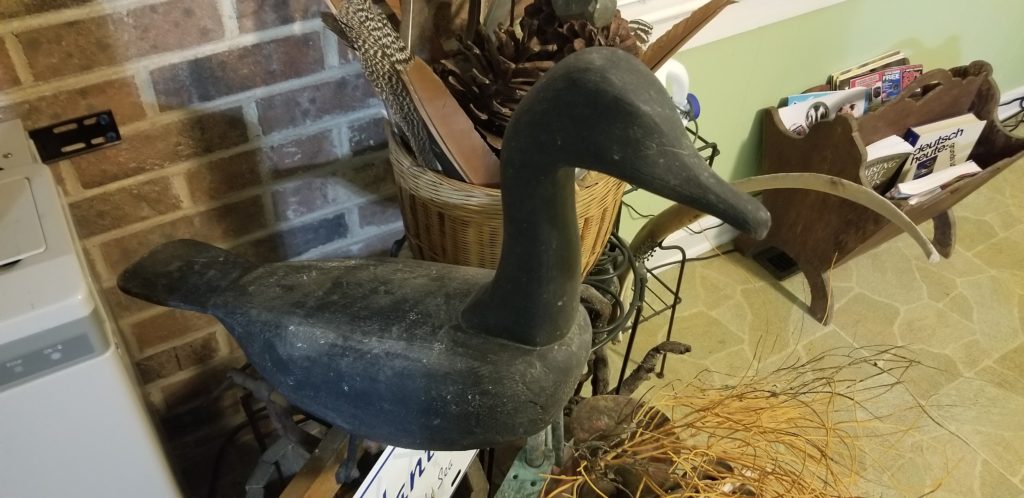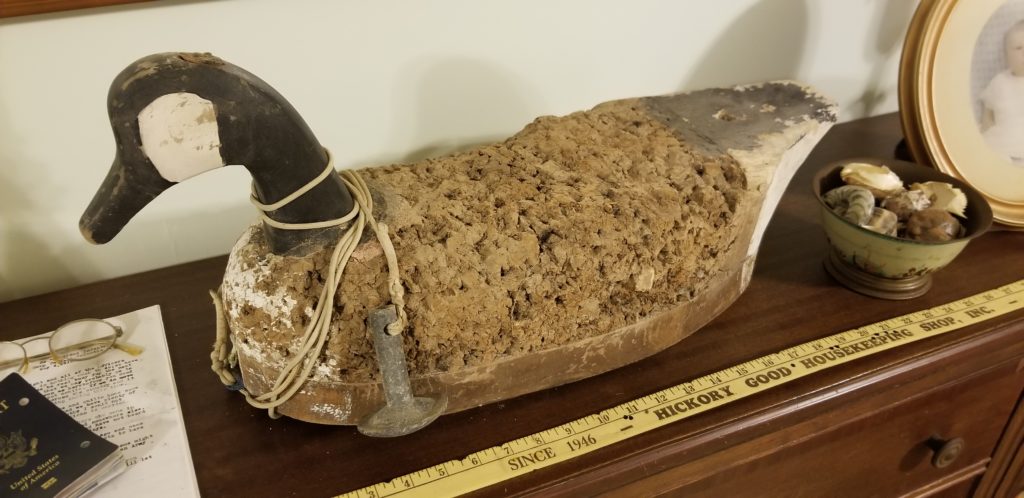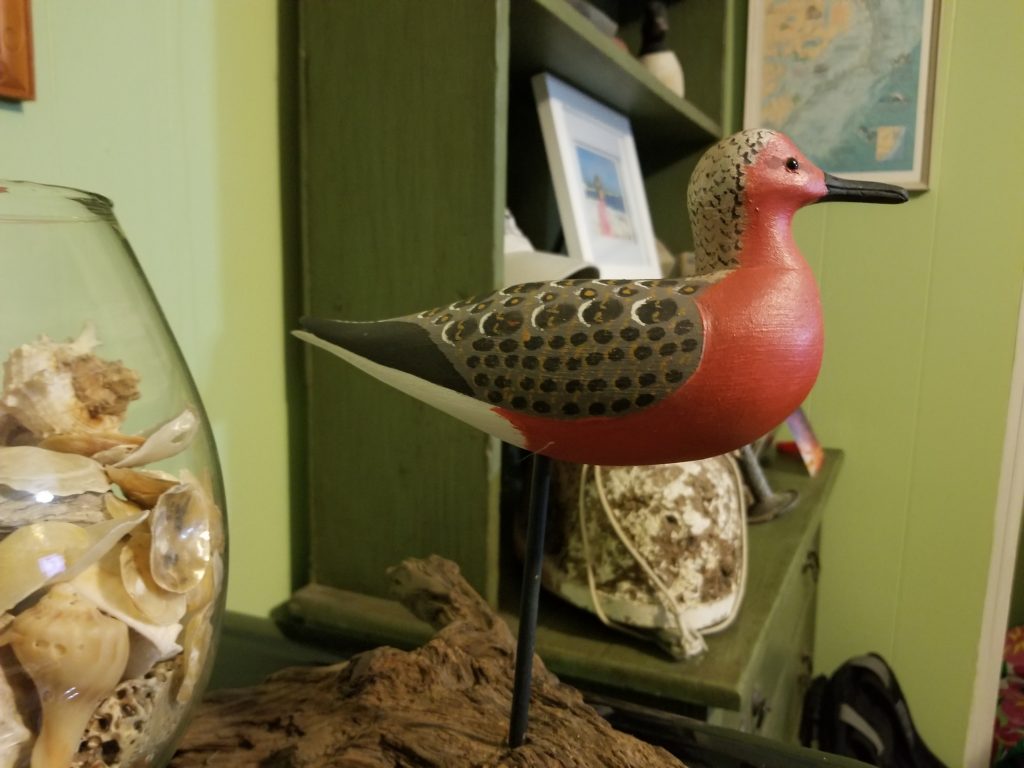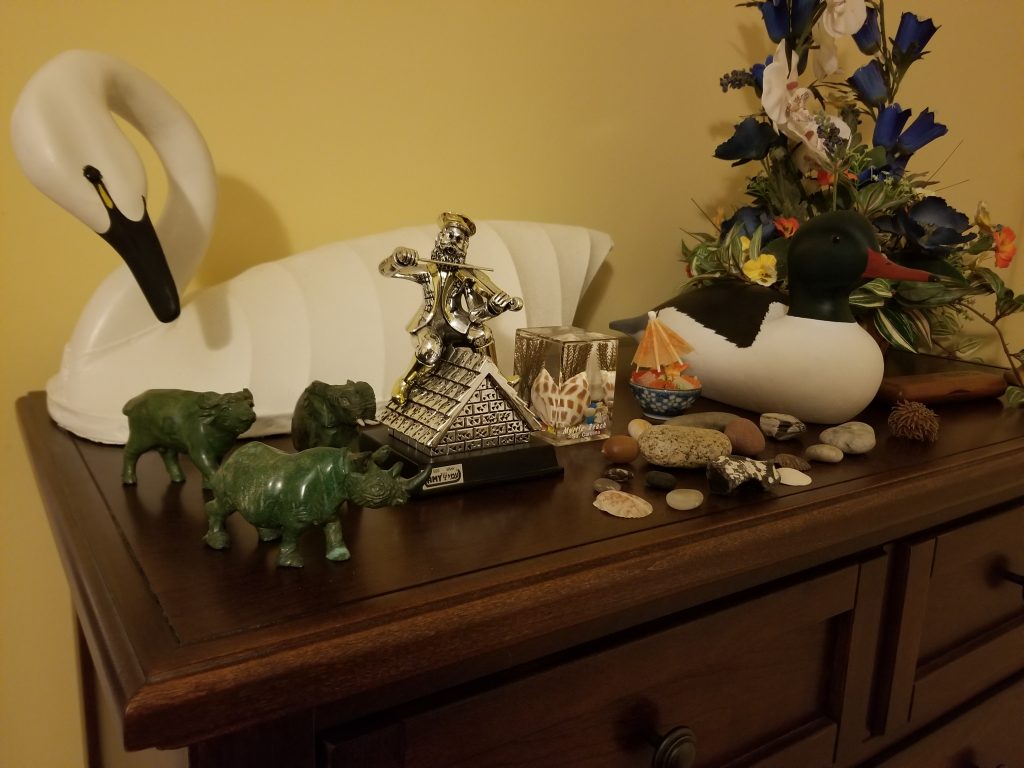Summary: This page is not relevant to JumpinMullet Charters, LLC. It’s my personal page that allows me to relax and remember times that have past, all in one place, and also show folks Daddy’s (Julian Hamilton, Jr.) and Granddaddy’s (Julian Hamilton, Sr.) decoys they made that I have now, scattered out in many locations of mine. Absolutely nothing on this page is for sale. Note these are just my decoys, and I have not included any of my family’s decoys…
Work in Progress: Whenever I remember and have some free time, I’ll update this page and add some more decoys. Some of the stories I will attach to some of the decoys may be useful to collectors, but they are really directed to my granddaughter to be this November 2019…
Brief Info about Daddy (Julian Hamilton, Jr.): 1925 – 2000. In 1995 he was awarded the North Carolina Heritage Award for his decoy carvings. He grew up in Beaufort, NC, because Granddaddy had moved from Atlantic, NC, to Beaufort, NC, during the Great Depression to work at First Citizens Bank. After serving in the Pacific Theater during World War II, he continued to live in Beaufort to raise waterfowl, work at Cherry Point as a Toolmaker, carve decoys, and loved to hunt and fish for the rest of his life.
Brief Info about Granddaddy (Julian Hamilton, Sr.): 1895 – 1967. He was from Atlantic but moved to Beaufort after graduating from Trinity College (now Duke University) and serving in France during World War I. He knew Mitchell Fulcher well, but I remember him best with Leck Lewis (from Stacy, NC) at our camp at the Evergreens, about 4 or 5 islands just south of Portsmouth Village). Leck and him “held down the camp” and cooked while everyone else hunted… I still remember their conversations, almost word for word, like it was yesterday…

I think if someone said everything you own is burning down, and I could only grab one decoy, this is the decoy I would grab to save. Notice the white “brow” over the eyes, which is unique to Giant Canada Geese. Daddy was a/the premier breeder of Giant Canada Geese, which were brought back from near extinction. We hunted with this bird to the Evergreens, and he was always placed as the lead gander in the decoys. The massive head, but not held up in alarm, sent a many a goose to Sunday dinner at our place… I love this decoy, and can still see him in my mind being the point gander… It’s the only Giant Canada goose decoy he ever made, so it truly is unique…

Three “generations” of Buffleheads (aka Dippers). There is a “4th generation” of Buffleheads, but I don’t own any of those. I love Granddaddy’s originals (on the left) with wood bottoms and balsa backs… The transition decoy in the middle was obviously hunted hard. I remember hunting with the two lead Buffleheads in the 1960’s just like it was yesterday… By then the decoys were larger and the balsa had been replaced by cork… Daddy made some more after he made the ones I hunted with shown here (I seem to recall the heads were bigger), but I don’t have any of those.

I absolutely love this “pair” of Black Ducks that were made by Granddaddy. Yea, the rigging and weights were made by Daddy, but the actual decoys were made by Granddaddy – absolutely no doubt! In fact, some of y’all who know the details to look for can tell even from this picture… Ha Ha I hunted with these birds in the 1960’s too… Yea, yea, yea, I know… the Black Ducks get put out to the leeward of the geese… Ha Ha

Daddy made two floating Seagull confidence decoys, and then later made this Cormorant confidence decoy with C-Clamp legs to secure it to the wall of one of his stake blinds. I remember him making this bird, and later I asked him how well it worked. He told me he fastened it to the stake blind like he intended, and then went back to the Evergreens for lunch, and as they headed back to the stake blind after lunch, he though it looked like a hunter standing up in the stake blind. He took it down, and never used it again… Ha Ha Daddy never had any use for a hunter who stood up in a blind looking for fowl…

Old birds. Made by Granddaddy. They’re so old Daddy never even branded them with his initials… On the other hand, I’m so old I actually remember hunting with them, but only in the early days of my hunting. You can see Daddy’s rigging on one of them… None of the crowd to the Evergreens got excited about shooting Blackheads, and back then it wasn’t legal to keep Redheads, so I don’t recall using these decoys past the late 1960’s… It doesn’t mean they weren’t used much past then, but I just don’t remember it. Of course, one look at these tells you they were used forever prior to then…

This bird, with the rest of Daddy’s flock of Brant decoys, saw plenty of action. I remember hunting with his Brant right up to the end. He always put them to the leeward of the geese, and I would always have have to get clarification, because that’s where the Black Ducks went too… Seems like the Brant were offshore, and the Black Ducks were inshore, but both decoy flocks were always behind the geese… We didn’t shoot many Brant back in the day, and they were mostly a novelty, but folks were always happy to shoot a few and take them home…

I have three of Granddaddy’s working geese. All were made at different times (probably different decades), but yet we hunted over all three (with their brothers and sisters) as one flock. These were part of the core flock of the 1960’s that I remember. I tried to keep one of each style (time period). These three are really important to me!

I have three of Granddaddy’s working geese. All were made at different times (probably different decades), but yet we hunted over all three (with their brothers and sisters) as one flock. These were part of the core flock of the 1960’s that I remember. I tried to keep one of each style (time period). These three are really important to me!

I have three of Granddaddy’s working geese. All were made at different times (probably different decades), but yet we hunted over all three (with their brothers and sisters) as one flock. These were part of the core flock of the 1960’s that I remember. I tried to keep one of each style (time period). These three are really important to me! As you can tell, Daddy recorked this one…

Cedar Ruddy Duck. It had been in our house for so many years, I was thinking Daddy had carved it, but once I turned it over, I realized it was Granddaddy’s. Now I vaguely remember it being at Granddaddy’s. The really interesting thing is that there are 3 sets of initials on the bottom of the duck. From top to bottom, they are JW, CE, and JH. I spoke with cousin Susan, and she thinks the JW is Joe Willis, who lived on the Back Road here to Atlantic, and was good friends with Charles Clip Edwards (CE) of Atlantic. Granddaddy would have been JH. I’ve never seen another one of this style, so I have no idea if there are others… I always thought it was beautiful…

If I had a chance to keep a second decoy if the house was burning down, this would be it. I do not recall ever hunting with this bird, as I figure Granddaddy had already put it on the shelf before I was born. It has clearly been hunted hard though, judging by all the hardware on its bottom (swivel and lead weights). It’s Granddaddy’s body with a Mitchell Fulcher head. I bet they were a beautiful sight on the water…

I vaguely remember this Long Tom (aka Great Blue Heron) at Granddaddy’s house. My thinking is that it is a one-of-a-kind unique bird, and predates all of the White Herons he later carved. That’s because all his White Herons used a Mitchell Fulcher pattern. This bird was not carved from a Mitchell Fulcher pattern. I’ve been told that the animated eyes likely have a Leck Lewis influence, which makes perfect sense, since Granddaddy and Leck were such good friends. I remember the first bird I ever shot “on-the-wing” was a Long Tom. We jumped him walking to the blind on Great Island (by the Evergreens). I couldn’t have been more than 10 years old, and used Daddy’s bolt action .410. We fried him up for supper with lots of flour and onions. He tasted great, and I was tickled. Years later I ate one, and wow, he was fishy tasting. My eating Long Tom days are over… Ha Ha

Daddy (and everyone else at the Evergreens) had another name for this kind of duck, s**tleg. I’ll just stop there, because if you ever watched them fly much, you’ll get it… Ha Ha Most folks, especially those from off, and also some local folks, won’t eat them, but we loved to eat them. We would skin the breasts and legs, cut away the meat, and throw the rest away. Fried in flour gravy with lots of onions, they were great! I enjoy eating them to this day! I vaguely remember Daddy making these birds, but do remember hunting with this flock of decoys right up to the end…

Daddy (and everyone else at the Evergreens) always called them “Pheasant.” Most folks down here still do. This decoy was made to be put on a shelf, and not hunted. I recall Daddy making several of these, but I don’t recall how many. Technically, we never really pheasant hunted, but they shared the same fresh water pond habitat as Black Ducks, and they were always good to bring back to the camp to eat.

I remember Mr. Leck well, as he used to go with Granddaddy to the Evergreens camp. Mr. Leck was a “character,” even though Granddaddy and him were more about just enjoying themselves by the time I came along. They both loved to tell stories… Every time I look at this bird, I smile…

Beach Robin (aka Red Knot). Granddaddy’s bird he made. This is the real deal. This was displayed on our shorebird “top shelf” for as long as I can remember.

Grayback (aka Dowitcher). Granddaddy made this “Top Shelf” bird. I suspect it was made to be put on a shelf, and not to be hunted. Graybacks were the bird of choice for me when I was very, very young. I’m not admitting to anything, but I heard they are excellent to eat!!! Willets too, but I don’t recall any Willet decoys… But never, under any circumstances, bring home a curlew… Only birds that were plentiful were acceptable…

All Daddy… Ha Ha I can’t remember how many of these he made, as I only recall him using one at the time. The timing was later toward the end of the goose hunting at the Evergreens…

We think Daddy made these in 1969, +/- a year. My brother Keith did most of the sanding, but Daddy did everything else… There were about 25 of them made. Unsinkable with the balsa wood bodies!!! We hunted with these right up to the end before the plastic decoys took over…

The best I recall, Daddy made an original swan all by himself. My sister has that swan. Later, Daddy made about a half dozen more swans (with Dave Gaskill’s help) based on Daddy’s original swan. This is one of those swans. It’s beautiful to me. It was never meant to be hunted, but was meant just to sit in living rooms. He made swan silhouettes for hunting, as they were much lighter in weight… 🙂 We hunted swans together in the northeast part of the state in his later years… It was about the only time he ever wanted to leave Carteret County…

From left to right, a Canvasback by Davis Springle, a Gadwall by Casey Arthur, and a Black Duck by Geoffrey Adair. I recall buying the Canvasback and the Gadwall at the schoolhouse at Harkers Island during Decoy Festival weekend in 2018 (+/- a year). The Black Duck was made in the 1970’s and was a gift to Daddy.

Black Ducks – Both have Mitchell Fulcher heads with Granddaddy’s bodies. Daddy would have done the rigging. I remember hunting with these in the very early days.
Curlew – Daddy made a dozen or so of these in his later years. He never painted them. About 10 years or so after he passed away, Brother Gaskill from Harkers Island painted them I think the one at the museum did not get painted, as well as a couple more…). Brother did an excellent job painting them!!! I ended up with this one. Yea!!!
Miniature Cedar Geese – This is the prettiest pair I could find. I have a few more pairs in various locations…

Beach Robin in foreground is a Julian Hamilton, Sr. bird. Full bodied. No question about it, and if you look at the bird in person, you will know why… Julian Hamilton, Jr. made the bird on the right. No question about that either. The top two birds are tougher… They came from the “outside,” being advertised as Granddaddy’s birds, but th e thinking is they were Daddy’s birds. If I had to totally guess, I would say Daddy, but it certainly could have been Granddaddy’s pattern, and they easily could have made them together…

Julian Hamilton, Jr. Beach Robin. Full bodied bird. I would totally guess he was carved in the 1970’s. Carved and painted for where he is a sitting.

I bought the swan from the “Mayor” of Atlantic, Jeff Gillie, in the Dollar General parking lot to Sea Level. Well, technically, Jeff wasn’t the “mayor,” but folks liked to call him that. He’s gone now, but his birds live on. Then and now, it is beautiful!
The Wayne Davis Merganser is also beautiful. I purchased it at the CSWM&HC auction in 2019.
They are both wonderful works of art!

Carved by Julian Hamilton Jr I would guess in 1962 or 1963. I remember him showing me this bird and telling me he paid Eugene Pond to paint it. Daddy didn’t have much experience painting “detail” on “indoor” decoys back then.
My sister sanded off Daddy’s brand underneath this decoy many years later because it was unique and she didn’t recall Daddy making it, but I remember, because I was many years older than my sister.
